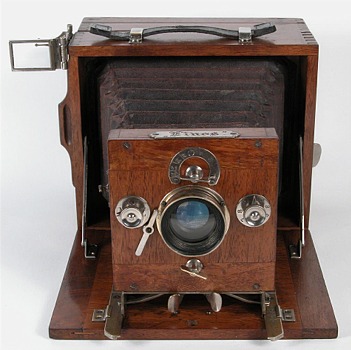
Linos Folding Plate Camera

The Linos is an antique wood-bodied folding plate camera manufactured by Dr. Lüttke & Arndt of Berlin, Germany, ca 1898. The Linos plate format is 9 x 12cm. This example is equipped with an accessory rollfilm back and does not have plate holders. The rollfilm format appears to be approximately 9 x 9cm.
This is a handsome, compact and relatively light camera. The body is made of walnut with fittings of nickel-plated brass. The Linos has a number of interesting design features. I'll point these out as we go along.
The Linos belonged to a class of cameras known in the late 19th century as hand and stand. Hand and stand cameras were intended to be used either handheld or mounted on a tripod. With a hand and stand camera mounted on a tripod, the subject was usually composed and focused on the camera's ground glass screen. When the Linos was handheld, the subject was composed via the folding Newton viewfinder, seen at top left in the image above. In this case proper focus was achieved by aligning a pointer mounted on the lensboard to a distance scale engraved on the focusing track.
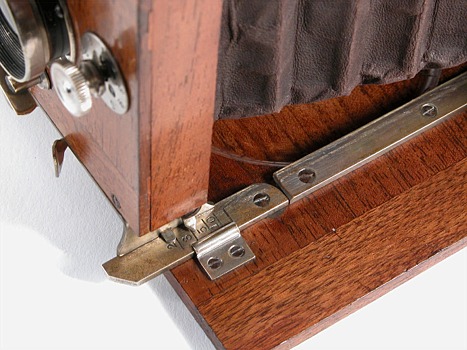
This is a view of the Linos distance scale. The scale is engraved at 2, 3, 5, 10 meters and infinity. In this image the pointer is near the 3 meter line. When the Newton viewfinder was used for framing, typically when the camera was handheld, the photographer needed to measure or estimate the camera-to-subject distance and set the pointer accordingly.
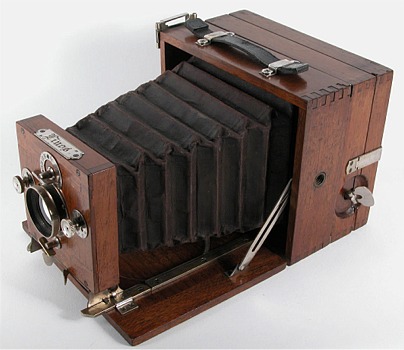
This is how the Linos appears when ready for use. The lensboard is pulled far forward onto foldable track extensions. The foldable extensions are unusual and perhaps unique. This feature allowed for a more compact camera. The track extensions are shown in greater detail in the next image.
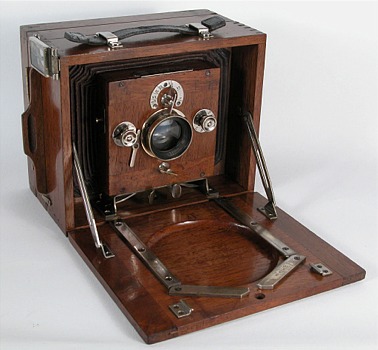
The lensboard is pulled onto the baseboard track by grasping two grips which serve to lock the lensboard in place. The lensboard glides easily from the casing onto the track. This quality is a bit unusual. On many similar folding cameras the lensboard does not move seamlessly as it is pulled from the casing track to the baseboard track.
Notice at the front of the tracks there are two bars of metal set at an angle. These are the foldable track extensions. The extensions automatically straighten as the lensboard is pulled fully into position. As the camera is closed up, the extensions fall back to the angle seen above. When the extensions are straight, they extend beyond the edge of the baseboard. If the track were fixed and straight its entire length, the camera casing would need to be taller. This interesting design feature allows for a more compact camera.
The center of the baseboard features a large round depression. Although this scallop adds character, its real purpose was to save space. With the camera closed, the lens fits into the depression, permitting a slimmer camera body.
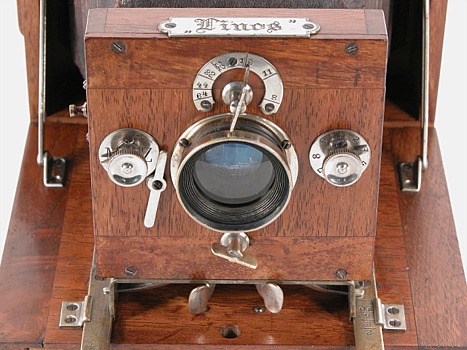
Although it is unmarked, all sources agree the lens is a 165mm Aplanat with a maximum aperture of f/8. The iris diaphragm stops down to f/64. The aperture setting control is located directly above the lens.
The shutter, built into the lensboard, has a wonderful retro-technical look. The shutter delivers nine instantaneous speeds as well as time and bulb. A turn of the key located below the lens tensions the sector shutter. The knob to the left of the lens is the shutter release. Pressing it in releases the shutter. The action is smooth and the shutter works beautifully.
The shutter release serves another purpose. It is used to select between instantaneous and time/bulb exposures. The knob's pointer is set to the letter M for instantaneous speeds and Z for time and bulb. The lever situated between the shutter release and lens is the control for time exposure. When Z is selected and the shutter release is pressed, then to lock the shutter on time, rotate the lever so its tip sits on top of the shutter release pointer. The lever holds the release in causing the shutter to remain open. To close the shutter, swing the lever away.
The dial to the right of the lens is the speed selector. Shutter speeds are numbered from 1 to 9.
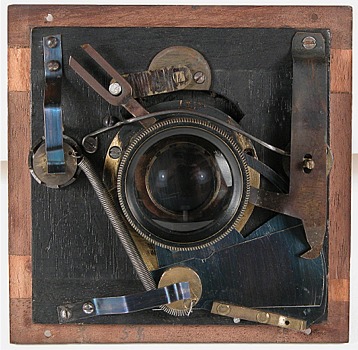
When I acquired this camera the aperture wasn't working. Notice a forked arm protruding from the lens mount at about eleven o'clock. This arm couples the aperture setting control to the iris diaphragm. I found the fork had become uncoupled. It was a simple matter to reconnect the fork to the control. The aperture is working well now.
The Linos has a spring-driven sector shutter. The sector and capping blades are visible in this view. The long spring on the left is connected at one end to the shutter blade arbor and at the other to the speed selector. The speed selector is set to its lowest tension, setting 1. Rotating the selector to a higher number increases the spring tension. Greater spring tension drives the blades faster resulting in shorter exposures.
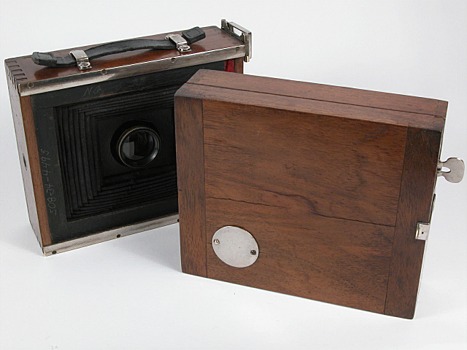
Like the camera, the Linos accessory rollfilm back is made of walnut with nickel-plated brass fittings. Aluminum is also used internally. At the end of the 1800s manufacturers were just beginning to experiment with aluminum in camera construction. The choice of aluminum in this case contributed significantly to a reduction in weight. It appears the designer of the Linos set about to create a compact and light weight camera.
Exposures are counted by viewing through a red window, numbers printed on the film's paper backing. The round metal disk on the face of the rollfilm back normally covers the red window. The disk is swung away to uncover the window while winding film, and then swung back in place to prevent excess light from fogging the film.
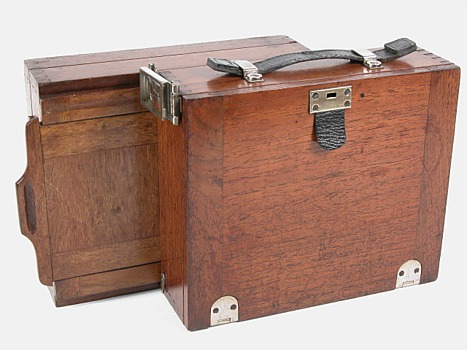
The rollfim back is shown partially attached to the camera. The back is attached in the same manner as a plate holder. The fit is excellent and the back glides smoothly into place. The rollfilm back is equipped with a dark slide. The dark slide handle can be seen protruding from the left. The purpose of the dark slide is to protect the film from light while the back is detached from the camera. Prior to making an exposure the dark slide needs to be withdrawn, allowing light from the lens to reach the film.
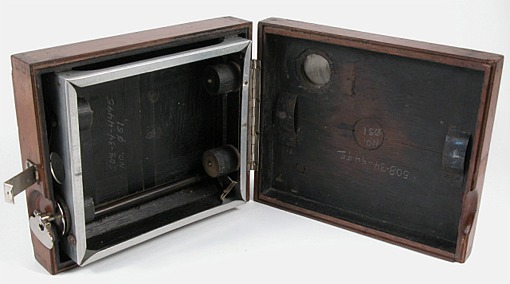
This is a view of the opened rollfilm back. To load and unload film the metal frame needs to be removed. This is done simply by pulling the frame out of the case. The frame is made of aluminum. If this part were made of steel or brass, the back would be heavier. The film wind key is ratcheted and operates smoothly.
An empty film spool did not accompany the back, so I can only speculate what size roll film it accepted. The distance between the spool holders is approximately 3 3/4 inches, or 95mm. Given this dimension, Kodak number 101 film may fit. Kodak 101 roll film was introduced in 1895. It is also possible that this holder was designed to use a non-Kodak film. The roll film image format appears to be approximately 9 x 9cm.

|
Page created October 8, 2003;
updated December 20, 2020 |